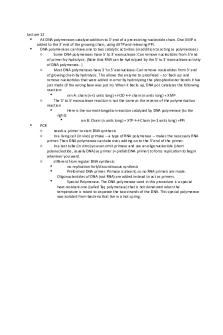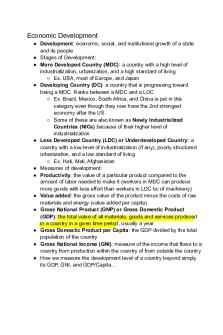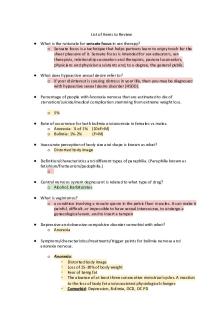Test 3 Review PDF

| Title | Test 3 Review |
|---|---|
| Course | Organic Chemistry |
| Institution | Conestoga College |
| Pages | 8 |
| File Size | 358 KB |
| File Type | |
| Total Downloads | 98 |
| Total Views | 155 |
Summary
Test 3 Review...
Description
Unit 7 ● Carboxylic Acids ○ Formula: R-COOH ○ Replace the ‘e’ ending with ‘oic acid’ ○ ortho (o) = 1,2 on the ring ○ meta (m) = 1,3 on the ring ○ para (p) = 1,4 on the ring ○ React with strong bases to form carboxylate salts ○ React with alcohols to produce ester and water ● Esters ○ Formula: R-COO-R ○ Replace ‘oic acid’ with ‘oate’ ○ Naming ■ Alcohol side (R-C=O) 1st then everything else ○ Acid hydrolysis produce carboxylic acid and alcohol
Unit 8 ● Amines ○ Formula: ■ Tertiary amines do not hydrogen bond to each other
○ Replace the ‘e’ ending with amines ■ Aromatic Amines ● The amine of benzene is named aniline (Systematic name = benzenamine) ■ Common Name ● Name the alkyl groups attached to the N in alphabetical order ● Add –amine ● The name is continuous, no spaces between groups ■ Alkylammonium Salts ● Name amine salts by replacing the suffix – amine with ammonium ● Add the name of the anion ● Converting amines to salts often makes insoluble amines soluble as the salts are ionic
○ Amines are weak bases ■ accept H+ when dissolved in water ○ boiling points between alkanes and alcohols ■ Tertiary amines boil lower than 1o or 2o of similar molecular weight ○ Heterocyclic Amines ■ Cyclic compounds ■ Have at least one double bond in the ring ● Amides ○ a reaction between a carboxylic acid derivative and an amine or ammonia ○ Formula:
○ Replace the ‘e’ ending with amides ■ Names are derived from the carboxylic acid ● Remove –oic acid and replace with –amide ■ Nitrogen substituents are prefixed to the name ● indicated by N○ Amides hydrolyze with: ■ Acid to produce ● Carboxylic acid ● Amine salt ■ Base to produce ● Carboxylic acid salt ● Amine o o ○ 1 and 2 amines react with acid chlorides and acid anhydrides to produce amides ○ Most amides are solids at room temperature due to internal hydrogen bonding
Other Important Information ● Common Name ○ Carboxylic Acids ■ Benzene → Benzoic Acid ■ Sodium acetate (Sodium ethanoate) ■ Acetic acid (ethanoic acid) ■ Butyric acid (butanoic acid) ■ Sodium propanoate or sodium propionate (sodium + propanoic acid)
○ Esters ■ Ethyl butyrate (ethyl butanoate) ■ Propyl propionate (propyl propanoate) ■ Propyl acetate (propyl ethanoate)
○ Amines ■ Methylamine (methanamine) ■ Dimethylamine (N, N - methanamine) ■ Trimethylamine (N, N - dimethylmethanamine) ■ Ethylamine (ethanamine) ■ Propylamine (propanamine) ■ butylamine (butanamine)
○ Amides ■ Ethanoic acid/acetic acid (ethanamide/acetamide)
■ ■ ■ ■ ■ ■
Propanoic acid/Propionic acid (propanamide/propionamide) Formamide (methanamide) Acetamide (ethanamide) Propionamide (propanamide) N-Methylformamide (N-Methylmethanamide) N-Methyacetamide (N-Methylethanamide)
● Remember* ○ Oxidizing Agent: Chromic Acid (H2CrO4) ○ Carboxylic Acids ■ Formula: R - COOH ■ Replace the ‘e’ ending with ‘oic acid’ ■ ortho (o) = 1,2 on the ring ■ meta (m) = 1,3 on the ring ■ para (p) = 1,4 on the ring ■ Carboxylate Salts ● Carboxylic Acids reacting with strong bases (NaOH) ● Replace ‘oic acid’ with ‘ate’ ● Formula: R-COO- Cation+ ■ React with alcohols to produce ester and water ○ Esters ■ Formula: R-COO-R ■ Replace ‘oic acid’ with ‘oate’ ■ Naming ● Alcohol side (R-C=O/R-CO) = yl ending ● Carboxylic side (C=OO-R/COO-R) = oate ending ■ Acid hydrolysis produce carboxylic acid and alcohol ● with heat and sulphuric acid (H2SO4) ● carboxylic acid and alcohol = heat and sulphuric acid ( H2SO4) ○ Amines ■ Formula: ● Tertiary amines do not hydrogen bond to each other
■ Replace the ‘e’ ending with amines ● Aromatic Amines ○ The amine of benzene is named aniline (Systematic name =
benzenamine) ● Common Name ○ Name the alkyl groups attached to the N in alphabetical order ○ Add –amine ○ The name is continuous, no spaces between groups ● Alkylammonium Salts ○ Name amine salts by replacing the suffix – amine with ammonium ○ Add the name of the anion ○ Converting amines to salts often makes insoluble amines soluble as the salts are ionic ○ Amides ■ Formula:
■ Replace the ‘e’ ending with amides ● Names are derived from the carboxylic acid ○ Remove –oic acid and replace with –amide ● Nitrogen substituents are prefixed to the name ○ indicated by N-
Unit 7 Summary of Reactions
Unit 8 Summary of Reactions
Unit 9 Charts NMR Chart
IR Chart
Unit 9 Guidelines 1. Look at the chemical formula for specific atoms (oxygen and/or nitrogen)
2. Check the FTIR spectra for functional groups related to the atoms found in the chemical formula a. If oxygen present, check for: i. ≈ 3400 cm -1 , big and broad “tongue” (Alcohol, O-H stretch) ii. ≈ 3400 cm -1 , big and very broad “hair beard” (Carboxylic acid, O-H stretch) iii. ≈ 1725 cm -1 , big and narrow “sword” (Carbonyl, C=O stretch) iv. ≈ 1150 cm -1 , big and narrow (Alcohol or ether, C-O stretch) b. If nitrogen present, check for: i. ≈ 3400 cm -1 , double peak (1 o amine) or single peak (2 o amine) N-H stretch ii. ≈ 1675 cm -1 , carbonyl peak also present indicates there’s an amide c. One last significant area to check: i. > 3000 cm -1 , C=C present and likely in a ring (sp 2 hybridized C-H stretch) ii. < 3000 cm -1 , C-C present (sp 3 hybridized C-H stretch) 3. 3. After identifying what functional groups are present, return to the chemical formula and draw all possible isomers of the compound. If this isn’t possible or there are too many possibilities refer to the NMR integration. 4. Refer to the integration on the NMR spectrum, remember chemically equivalent protons! a. 1H – commonly refers to a CH or OH b. 2H – commonly refers to CH 2 c. 3H – refers to CH 3 d. 4H – refers to 2 CH 2 groups with chemically equivalent protons e. 6H – refers to 2 CH 3 groups with chemically equivalent protons (iso-) f. Even #> 6H – refers to carbon chain with many CH 2 5. Draw the compound and confirm identity with NMR integration and downfield shifts (ppm) TL;DR 1. Look at the atoms in the chemical formula 2. Check IR for functional groups related to atoms 3. Draw possible structures 4. Check NMR integration, identify alkyl groups 5. Determine compound...
Similar Free PDFs

TEST 3 - test 3 review
- 19 Pages

MCBL Test 3 - Review for test 3
- 6 Pages

Test 3 Review
- 2 Pages

Test 3 - Review
- 2 Pages

Test 3 Review
- 8 Pages

Review Test 3
- 2 Pages

MPO Test 3 Review
- 9 Pages

Test 3 Review Questions
- 7 Pages

Test 3 review - Prof. Mowsh
- 15 Pages

Human geography test 3 review
- 10 Pages

Unit 3 Psychology Test Review
- 5 Pages

Philosphy 150 test review 3
- 3 Pages

Abnormal Review for Test #3
- 6 Pages

Test Review
- 43 Pages

CHE 1301 Exam 3 Test Review
- 7 Pages
Popular Institutions
- Tinajero National High School - Annex
- Politeknik Caltex Riau
- Yokohama City University
- SGT University
- University of Al-Qadisiyah
- Divine Word College of Vigan
- Techniek College Rotterdam
- Universidade de Santiago
- Universiti Teknologi MARA Cawangan Johor Kampus Pasir Gudang
- Poltekkes Kemenkes Yogyakarta
- Baguio City National High School
- Colegio san marcos
- preparatoria uno
- Centro de Bachillerato Tecnológico Industrial y de Servicios No. 107
- Dalian Maritime University
- Quang Trung Secondary School
- Colegio Tecnológico en Informática
- Corporación Regional de Educación Superior
- Grupo CEDVA
- Dar Al Uloom University
- Centro de Estudios Preuniversitarios de la Universidad Nacional de Ingeniería
- 上智大学
- Aakash International School, Nuna Majara
- San Felipe Neri Catholic School
- Kang Chiao International School - New Taipei City
- Misamis Occidental National High School
- Institución Educativa Escuela Normal Juan Ladrilleros
- Kolehiyo ng Pantukan
- Batanes State College
- Instituto Continental
- Sekolah Menengah Kejuruan Kesehatan Kaltara (Tarakan)
- Colegio de La Inmaculada Concepcion - Cebu
